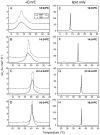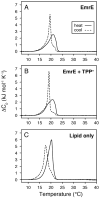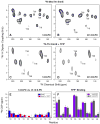Assessing Interactions Between a Polytopic Membrane Protein and Lipid Bilayers Using Differential Scanning Calorimetry and Solid-State NMR
- PMID: 29457729
- PMCID: PMC5921866
- DOI: 10.1021/acs.jpcb.8b00479
Assessing Interactions Between a Polytopic Membrane Protein and Lipid Bilayers Using Differential Scanning Calorimetry and Solid-State NMR
Abstract
It is known that the lipid composition within a cellular membrane can influence membrane protein structure and function. In this Article, we investigated how structural changes to a membrane protein upon substrate binding can impact the lipid bilayer. To carry out this study, we reconstituted the secondary active drug transporter EmrE into a variety of phospholipid bilayers varying in headgroup and chain length and carried out differential scanning calorimetry (DSC) and solid-state NMR experiments. The DSC results revealed a difference in cooperativity of the lipid phase transition for drug-free EmrE protonated at glutamic acid 14 (i.e., proton-loaded form) and the tetraphenylphosphonium (TPP+) bound form of the protein (i.e., drug-loaded form). To complement these findings, we acquired magic-angle-spinning (MAS) spectra in the presence and absence of TPP+ by directly probing the phospholipid headgroup using 31P NMR. These spectra showed a reduction in lipid line widths around the main phase transition for samples where EmrE was bound to TPP+ compared to the drug free form. Finally, we collected oriented solid-state NMR spectra on isotopically enriched EmrE that displayed chemical shift perturbations to both transmembrane and loop residues upon TPP+ binding. All of these results prompt us to propose a mechanism whereby substrate-induced changes to the structural dynamics of EmrE alters the surrounding lipids within the bilayer.
Figures





Similar articles
-
Correlating lipid bilayer fluidity with sensitivity and resolution of polytopic membrane protein spectra by solid-state NMR spectroscopy.Biochim Biophys Acta. 2015 Jan;1848(1 Pt B):334-41. doi: 10.1016/j.bbamem.2014.05.003. Epub 2014 May 13. Biochim Biophys Acta. 2015. PMID: 24835018 Free PMC article.
-
Interaction of a peptide model of a hydrophobic transmembrane alpha-helical segment of a membrane protein with phosphatidylethanolamine bilayers: differential scanning calorimetric and Fourier transform infrared spectroscopic studies.Biophys J. 1995 Mar;68(3):847-57. doi: 10.1016/S0006-3495(95)80261-4. Biophys J. 1995. PMID: 7756552 Free PMC article.
-
The use of high-resolution solid-state NMR spectroscopy and differential scanning calorimetry to study interactions of anaesthetic steroids with membrane.Biochim Biophys Acta. 1997 Aug 14;1328(1):65-73. doi: 10.1016/s0005-2736(97)00078-3. Biochim Biophys Acta. 1997. PMID: 9298946
-
Solid-State NMR of Membrane Proteins in Lipid Bilayers: To Spin or Not To Spin?Acc Chem Res. 2021 Mar 16;54(6):1430-1439. doi: 10.1021/acs.accounts.0c00670. Epub 2021 Mar 3. Acc Chem Res. 2021. PMID: 33655754 Free PMC article. Review.
-
Recent advances in magic angle spinning solid state NMR of membrane proteins.Prog Nucl Magn Reson Spectrosc. 2014 Oct;82:1-26. doi: 10.1016/j.pnmrs.2014.07.001. Epub 2014 Jul 26. Prog Nucl Magn Reson Spectrosc. 2014. PMID: 25444696 Review.
Cited by
-
Site-specific resolution of anionic residues in proteins using solid-state NMR spectroscopy.J Biomol NMR. 2020 Jul;74(6-7):355-363. doi: 10.1007/s10858-020-00323-z. Epub 2020 Jun 8. J Biomol NMR. 2020. PMID: 32514875 Free PMC article.
-
Emerging Diversity in Lipid-Protein Interactions.Chem Rev. 2019 May 8;119(9):5775-5848. doi: 10.1021/acs.chemrev.8b00451. Epub 2019 Feb 13. Chem Rev. 2019. PMID: 30758191 Free PMC article. Review.
-
Multiple frequency saturation pulses reduce CEST acquisition time for quantifying conformational exchange in biomolecules.J Biomol NMR. 2018 May;71(1):19-30. doi: 10.1007/s10858-018-0186-1. Epub 2018 May 23. J Biomol NMR. 2018. PMID: 29796789 Free PMC article.
-
Spectroscopic signatures of bilayer ordering in native biological membranes.Biochim Biophys Acta Biomembr. 2022 Jun 1;1864(6):183891. doi: 10.1016/j.bbamem.2022.183891. Epub 2022 Feb 22. Biochim Biophys Acta Biomembr. 2022. PMID: 35217001 Free PMC article.
-
Inducing conformational preference of the membrane protein transporter EmrE through conservative mutations.Elife. 2019 Oct 22;8:e48909. doi: 10.7554/eLife.48909. Elife. 2019. PMID: 31637997 Free PMC article.
References
-
- Riske KA, Barroso RP, Vequi-Suplicy CC, Germano R, Henriques VB, Lamy MT. Lipid bilayer pre-transition as the beginning of the melting process. Biochim Biophys Acta, Biomembr. 2009;1788:954–963. - PubMed
-
- Zhang YP, Lewis RNAH, Hodges RS, Mcelhaney RN. Interaction of a peptide model of a hydrophobic transmembrane alpha-helical segment of a membrane-protein with phosphatidylcholine bilayers - differential scanning calorimetric and FTIR spectroscopic studies. Biochemistry. 1992;31:11579–11588. - PubMed
-
- Yeagle PL. Cholesterol and the cell-membrane. Biochim Biophys Acta. 1985;822:267–287. - PubMed
Publication types
MeSH terms
Substances
Grants and funding
LinkOut - more resources
Full Text Sources
Other Literature Sources

